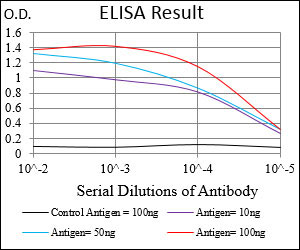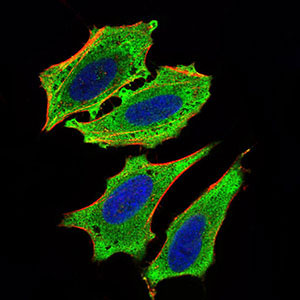MLXIPL Antibody
Purified Mouse Monoclonal Antibody
- SPECIFICATION
- CITATIONS
- PROTOCOLS
- BACKGROUND

Application
| WB, ICC, E |
|---|---|
| Primary Accession | Q9NP71 |
| Reactivity | Human |
| Host | Mouse |
| Clonality | Monoclonal |
| Clone Names | 5D12D1 |
| Isotype | IgG1 |
| Calculated MW | 93.1kDa |
| Description | This gene encodes a basic helix-loop-helix leucine zipper transcription factor of the Myc/Max/Mad superfamily. This protein forms a heterodimeric complex and binds and activates, in a glucose-dependent manner, carbohydrate response element (ChoRE) motifs in the promoters of triglyceride synthesis genes. The gene is deleted in Williams-Beuren syndrome, a multisystem developmental disorder caused by the deletion of contiguous genes at chromosome 7q11.23. |
| Immunogen | Purified recombinant fragment of human MLXIPL (AA: 18-143) expressed in E. Coli. |
| Formulation | Ascitic fluid containing 0.03% sodium azide. |
| Gene ID | 51085 |
|---|---|
| Other Names | Carbohydrate-responsive element-binding protein, ChREBP, Class D basic helix-loop-helix protein 14, bHLHd14, MLX interactor, MLX-interacting protein-like, WS basic-helix-loop-helix leucine zipper protein, WS-bHLH, Williams-Beuren syndrome chromosomal region 14 protein, MLXIPL, BHLHD14, MIO, WBSCR14 |
| Dilution | E~~1/10000 WB~~1/500 - 1/2000 IF~~1/200 - 1/1000 |
| Storage | Maintain refrigerated at 2-8°C for up to 6 months. For long term storage store at -20°C in small aliquots to prevent freeze-thaw cycles. |
| Precautions | MLXIPL Antibody is for research use only and not for use in diagnostic or therapeutic procedures. |
| Name | MLXIPL |
|---|---|
| Synonyms | BHLHD14, MIO, WBSCR14 |
| Function | Binds DNA as a heterodimer with MLX/TCFL4 and activates transcription. Binds to the canonical E box sequence 5'-CACGTG-3'. Plays a role in transcriptional activation of glycolytic target genes. Involved in glucose-responsive gene regulation (By similarity). Regulates transcription in response to changes in cellular carbohydrate abundance such as occurs during fasting to feeding metabolic transition. Refeeding stimulates MLXIPL/ChREBP transcription factor, leading to increased BCKDK to PPM1K expression ratio, phosphorylation and activation of ACLY that ultimately results in the generation of malonyl-CoA and oxaloacetate immediate substrates of de novo lipogenesis and gluconeogenesis, respectively (By similarity). |
| Cellular Location | Nucleus. |
| Tissue Location | Expressed in liver, heart, kidney, cerebellum and intestinal tissues |
If you have used an Abcepta product and would like to share how it has performed, please click on the "Submit Review" button and provide the requested information. Our staff will examine and post your review and contact you if needed.
If you have any additional inquiries please email technical services at tech@abcepta.com.














 Foundational characteristics of cancer include proliferation, angiogenesis, migration, evasion of apoptosis, and cellular immortality. Find key markers for these cellular processes and antibodies to detect them.
Foundational characteristics of cancer include proliferation, angiogenesis, migration, evasion of apoptosis, and cellular immortality. Find key markers for these cellular processes and antibodies to detect them. The SUMOplot™ Analysis Program predicts and scores sumoylation sites in your protein. SUMOylation is a post-translational modification involved in various cellular processes, such as nuclear-cytosolic transport, transcriptional regulation, apoptosis, protein stability, response to stress, and progression through the cell cycle.
The SUMOplot™ Analysis Program predicts and scores sumoylation sites in your protein. SUMOylation is a post-translational modification involved in various cellular processes, such as nuclear-cytosolic transport, transcriptional regulation, apoptosis, protein stability, response to stress, and progression through the cell cycle. The Autophagy Receptor Motif Plotter predicts and scores autophagy receptor binding sites in your protein. Identifying proteins connected to this pathway is critical to understanding the role of autophagy in physiological as well as pathological processes such as development, differentiation, neurodegenerative diseases, stress, infection, and cancer.
The Autophagy Receptor Motif Plotter predicts and scores autophagy receptor binding sites in your protein. Identifying proteins connected to this pathway is critical to understanding the role of autophagy in physiological as well as pathological processes such as development, differentiation, neurodegenerative diseases, stress, infection, and cancer.





